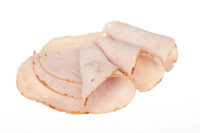Sliceability of sectioned and formed meat products is affected by the bind-strength between meat pieces cooked together in the casing or mold and the firmness of the meat pieces. Product bind results from the extraction of muscle proteins to the surface of meat pieces, to produce a protein exudate that is sufficient to bind the pieces together during the cooking process and to hold them together during slicing. Poor binding products will tear and break apart during high-speed slicing, resulting in a lower percentage of sellable product.
Meat product firmness is related to protein extraction and is affected by muscle quality (lack of the pale, soft and exudative/PSE condition), and product temperature. PSE pork, when cooked, has a soft texture that falls apart, and is sometimes described as tuna muscle, because of this appearance. Turkey breasts are also susceptible to PSE-like condition which causes soft texture and poor binding ability.
Protein extraction from meat chunks is maximized by the proper combination of salt, phosphates and water, the use of macerators to score the surface of cuts, the sufficient mechanical action from vacuum tumbling or massaging. Increased phosphate content (within regulatory limits), smaller meat chunk size, longer tumbling times, faster tumbling speeds have all been associated with improved binding ability of meat chunks. In the past, phosphates were shown to have the greatest impact on the protein composition of the exudate produced during tumbling. I have found the tetrasodium pyrophosphate to be the most effective in extracting myosin from post-rigor muscle. Addition of other non-meat ingredients, such as whey proteins and non-fat dry milk have also been claimed to improve sliceability of meat products.
Product firmness, besides controlling the quality of the in-going raw materials, is also increased with protein extraction as mentioned previous. If taken too far, this increase in firmness can be described as a rubbery texture. Product firmness can also be increased using colder product temperatures. Whereas it varies with different products and equipment suppliers, I have found optimal slicing of many meat products to occur at product temperatures of approximately 26ËšF although each slicer does have an optimum temperature for each particular product. There are some claims that crust freezing products will also improve the sliceability.
In the case of emulsion-type products, the binding of both fat and water will affect sliceability. Free fat, resulting from marginal emulsions, can contribute to fat build-up on slicer blades. Proper formulation and appropriate manufacturing techniques to extract sufficient protein are critical to stabilize the batter.
In the case of bacon, the consistency of the fat and the presence or absence of pickle pockets can affect slicing yields. If the fat is soft and oily, a lower-than-normal slicing temperature may be required. Conversely, hard, brittle fat may force a higher slicing temperature. Pickle pockets are typically reduced by injecting at lower injection pressures. NP





